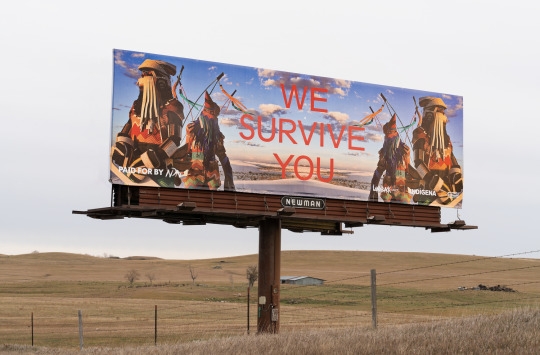#cannupa hanska luger
Photo

Cannupa Hanska Luger, (No)stalgia, 2020, ceramic, steel, and fiber, 62 × 62 × 32 in (157.5 × 157.5 × 81.3 cm)
12K notes
·
View notes
Text

Dance Clubs
Cannupa Hanska Luger, 2022
6 ceramic and walnut objects with synthetic hair, fuel hose, synthetic sinew and vermillion ink
Photo by @garthgreenangallery
Dance Clubs is a series of objects designed to be held in ones hand for a performance which is never to be activated.
Comprised of gas pumps slip cast in ceramic, coated with a brilliant orange ink, intended to stain ones hand if touched. The visual language is based on Indigenous war clubs of my ancestors - the ceramic and hand carved wooden clubs mirror the ingenuity in creating new technology - These objects transpose power of one idea into another, they are artifacts of necessary behavior shifts and a warning for humanity to pivot from our current actions if we are to survive as a species.
Now on view for BELONGING: Contemporary Native Ceramics from the Southern Plains now at the Louise Hopkins Underwood Center for the Arts, Texas through March 23, 2024. Participating Artists: Karita Coffey (Comanche), Chase Kahwinhut Earles (Caddo), Anita Fields (Osage/Muscogee), Raven Halfmoon (Caddo/Choctaw/Delaware), Cannupa Hanska Luger (Mandan/Hidatsa/Arikara/Lakota), Jane Osti (Cherokee National Treasure), Cortney YellowHorse-Metzger (Osage)
“This exhibit spotlights the diversity of contemporary ceramics practices among Native American artists in the region, and their reflections on belonging based in particular cultural roots, ancestral connections, personal insights, and individual experiences. Curating selected works from eight Native artists, this show incorporates a range of artistic practices from futuristic and customary works based on vessel forms, to more experimental practices that push clay in new directions through multi-media installation and performance.”
(via cannupahanska on Instagram)
#this is so fucking good i haaad to share#also i want to make a tag for references#yes i am using tumblr in my actual professional artistic practice#do not question my methods#contemporary art#contemporary sculpture#cannupa hanska luger#indigenous art#indigenous contemporary art#Three Affiliated Tribes of Fort Berthold#lakota#mandan#hidatsa#arikaya#standing rock#standing rock north dakota#new mexico#native american art#fine art#material culture#ceramics
1 note
·
View note
Text

Savage Noble, 2017, by Cannupa Hanska Luger
This figure, a mashup of man, lion, and scorpion, is Luger’s riff on colonial power and romantic stereotypes. “We see this beast for what it is, so now we may slay it,” he says.
#cannupa hanska luger#mixed media art#sculpture#modern art#contemporary art#fiber art#mythological creature
0 notes
Text
Collecting Indigenous Art: From Oaxaca to New Mexico and Back
Collecting Indigenous Art: From Oaxaca to New Mexico and Back
On June 16, 2022, the New York Times published a story about Native American artist Cannupa Hanska Luger focusing on the tension between what white collectors’ want and how the native artist responds. Titled Cannupa Hanska Luger is Turning the Tables on the Art World, the story digs deep into artistic expression, art as social commentary and political activism, and why art is made and for…
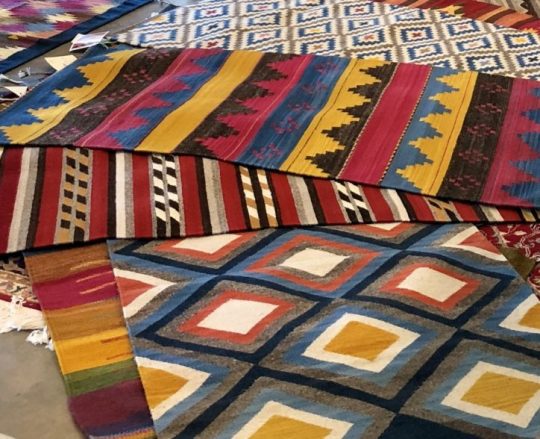
View On WordPress
#artisan#artist#Cannupa Hanska Luger#collecting#craft#indigenous#Mexico#native american#New Mexico#New York Times#Oaxaca#Why we collect art
1 note
·
View note
Text
in september of last year the university of michigan museum of art hired an Indigenous artist named cannupa hanska luger to do a monumental statement piece relating to the university's presence on Indigenous land. since luger is a ceramics guy he was like "ok I'll paint the front of the building white using slip made from native clay to make a point about how museums are a white people thing. and it's clay so it'll wash away pretty quick"

it's still white. I think it's so funny
10 notes
·
View notes
Text
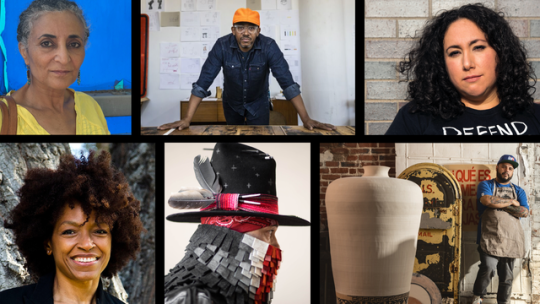
Cranbrook Academy of Art Announces Public Lecture Series With Artists, Architects, Curators, and Designers (Sponsor)
The 2023–2024 public lecture series at Cranbrook Academy of Art brings together an innovative group of artists, architects, curators, and designers to address some of the most urgent issues of our time through performance, object making, curation, and critical writing. Together, they encourage us to think expansively about the role of creativity in building community and in shaping the world around us.
The visiting artists include:
October 19, 2023, 6 p.m.
Risa Puleo, Independent Curator
November 9, 2023, 6 p.m.
Norman Teague, Designer and Educator
November 30, 2023, 6 p.m.
Hamza Walker, Director of LAXART
December 14, 2023, 6 p.m.
Cannupa Hanska Luger, Multidisciplinary Artist
January 11, 2024, 6 p.m.
Yolande Daniels, Associate Professor in Architecture at the Massachusetts Institute of Technology and co-founder of studioSUMO
February 1, 2024, 6 p.m.
Ghada Amer, Artist
February 22, 2024, 6 p.m.
Andrianna Campbell-LaFleur, Art Critic, Curator, and Historian
March 21, 2024, 6 p.m.
Yuri Suzuki, Sound Artist, Designer, Electronic Musician
April 4, 2024, 6 p.m.
Roberto Lugo, Artist, Social Activist, Poet, and Educator
12 notes
·
View notes
Text
0 notes
Text

Mirror Shield Project, Cannupa Hanska Luger.
0 notes
Photo

Cannupa Hanska Luger, Kill Time, 2022, acrylic on canvas and mixed media, 110 x 193 inches
12 notes
·
View notes
Text
Cannupa Hanska Luger extra credit lecture
Art and Nature Intertwined
The most important thesis I gathered from Cannupa Hanska Luger’s lecture was how “we need to study and help to understand nature around us instead of dominating it.” Doing this allows us to feel a sense of belonging in our world and allows us to have relationships with others, as Luger went over in his lecture. I learned a lot listening to the lecture about his work, as a lot of what he was saying align with my values and how I see the world. One of the main ideas he discussed was how it is important to connect ourselves and our relationship with the physical world around us. He also discusses how we are an extension of nature, all of these ideas bringing me to the thesis I found most valuable.
Hanska Luger supports his thesis of how it is important to understand nature around us through his work. Most of his work features materials that resemble the earth and nature, one of his most popular materials being clay. Luger uses clay in his work often, as it “signifies our relationship to a place or physical land.” His pieces of art often represent different cultures, as he likes to represent different people in his work. This means “speculatism”, which involves the relationships between others. Luger believes that respecting physical land as well as relationships with others is something everyone should value most in life, which is why he bases his work around it. I find this very inspiring because having relationships with people of different cultures and backgrounds is something I find very important, as well as learning more about the world around me and respecting physical land. If we study nature and respect it, then it can also help us grow relationships with people around the world and of different cultures. Luger shows this in his work as a lot of it is based on different cultures, including natives.
Another idea Luger discussed in his lecture that helped me explore the thesis was how we are “an extension of nature”, in his own words. I believe this means we as individuals are all connected to nature and the physical environment, which is why it is so important for us to study nature instead of dominating it and not treating it with respect. Understanding why nature is so important to our environment and our studies is the first step to becoming a true extension of nature that Luger described. To be in touch with nature allows us to be more in touch with ourselves, and a great way to explore this is through art, as Luger’s work shows. He uses his art projects to spread these ideas to others, and to help educate people about nature.
Luger’s lecture on his art really made me think more about the physical environment around me and how important nature is. I really like how he incorporates these ideas in his work, even including materials that represent the earth. This lecture really helped me understand the importance of studying nature and different cultures, and how it impacts us as individuals and our relationships with others.
0 notes
Text
Kunst und Aktivismus: Umweltschutz und zeitgenössische indigene Kunst

Begleiten Sie die vorgestellten Künstler und den Kurator der Ausstellungen "Water Memories" und "Art of Native America: The Charles and Valerie Diker Collection" zu einem Gespräch über die Bedeutung des Wassers für verschiedene indigene Völker und Nationen in den Vereinigten Staaten, die in historischer, moderner und zeitgenössischer Kunst zum Ausdruck kommt. Tauchen Sie ein in die künstlerischen Prozesse der Künstler und untersuchen Sie gleichzeitig die laufende Arbeit zum Schutz von Wasser und Land, den ästhetischen Aktivismus und die einzigartigen Herausforderungen, denen sich zeitgenössische indigene Künstler und Aktivisten gegenübersehen.
- Peter B. Jones (Onondaga), Künstler
- Cannupa Hanska Luger (Mandan, Hidatsa, Arikara, und Lakota), Künstlerin
- Cara Romero (Chemeheuvi), Künstlerin
- Patricia Marroquin Norby (Purépecha), Stellvertretende Kuratorin für indianische Kunst, The American Wing, The Met
Präsentiert in Verbindung mit den Ausstellungen "Water Memories" und "Art of Native America: Die Charles und Valerie Diker Sammlung".
Dieses Gespräch wurde am 30. März 2023 aufgezeichnet.
Read the full article
0 notes
Photo
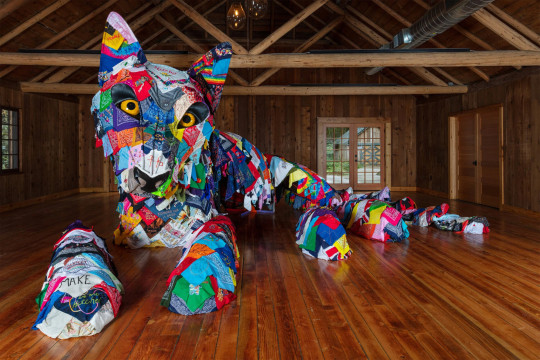
“Each/Other,” (2021) about 700 bandannas, approximately 16 x 9 feet, a collaboration between Marie Watt and Cannupa Hanska Luger
An Expansive Exhibition Pairs Two Indigenous Artists to Explore the Power of Socially Engaged Artmaking
A monumental patchwork wolf, warriors sparring with a fang-bearing snake, and an abstract woolen tapestry made of restored blankets comprise Each/Other: Marie Watt and Cannupa Hanska Luger, which opens this weekend at the Denver Art Museum. The expansive exhibition—featuring 26 mixed-media sculptures, installations, and wall hangings—joins two of the leading Indigenous artists working today in a manner that distinguishes both the connective threads and nuances within their bodies of work.

Cannupa Hanska Luger, “Every One” (2018), ceramic, social collaboration, 12 x 15 x 3 feet.
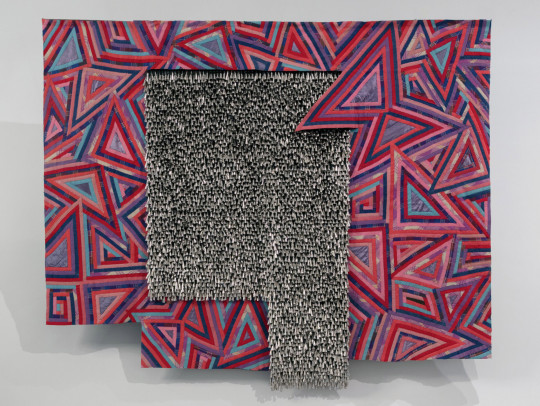
Marie Watt (Seneca), “Butterfly” (2015), reclaimed wool blankets, satin binding, thread, cotton twill tape, and tin jingles, 94 x 126 inches.

Cannupa Hanska Luger, “This Is Not A Snake” (2017-2020), ceramic, fiber, steel, oil drums, concertina wire, ammunition cans, trash, found objects, 78 x 36 x 600 inches. “The One Who Checks & The One Who Balances” (2018), ceramic, riot gear, afghan, wool surplus industrial felt, beadwork by Kathy Elkwoman Whitman; 6-1/2 feet x 12 inches x 8 inches (each, approximate).

Marie Watt “Companion Species (Radiant)” (2017), crystal and western maple base, 8 x 27 x 16 inches.

Cannupa Hanska Luger “Mirror Shield Project” (2016), drone operation/performance organization by Rory Wakemup., at Oceti Sakowin camp, Standing Rock, North Dakota
#marie watt#cannupa hanska luger#artist#art#art exhibition#indigenous artists#social engaged artmarking#each/other#denver art museum#mixed media sculptures#installations#wall hangings
16 notes
·
View notes
Photo

#COLLECTIVEFURY
Join Demian DinéYazhi´+ Cannupa Hanska Luger at Recess in Brooklyn, NY, as they debut a new performance piece that is a commentary on Indigenous masculine identity, residential boarding schools, enacting agency as radical trust and mutual care, the sacredness of Indigenous bodies, and a million other things that create cosmic savages.
Lou Cornum @spaceface2.0 will also present and read from the #COLLECTIVEFURY Critical Writing Fellowship piece.
Bring yr community out and SUPPORT LIVING INDIGENOUS POETS + ARTISTS!
@recessart | 07 FEB 2019 - 7PM
46 Washington Ave., Brooklyn, NY
For more information on #COLLECTIVEFURY :
https://www.recessart.org/demian-dineyazhi-r-i-s-e/
#COLLECTIVEFURY#COLLECTIVE FURY#RISEINDIGNEOUS#RECESS#RECESS ART#BROOKLYN#BROOKLYN ART#INDIGENOUS ART#DEMIAN DINEYAZHI#CANNUPA HANSKA LUGER#LOU CORNUM#INDIGENOUS AESTHETICS#NATIVE ART#INDIGENOUS PERFORMANCE#PERFORMANCE ART#RESIDENTIAL BOARDING SCHOOLS#NATIVE AMERICAN MAN#COSMIC SAVAGES#RISE INDIGENOUS
12 notes
·
View notes

